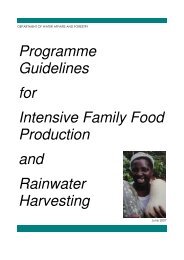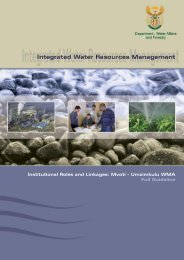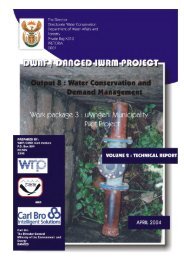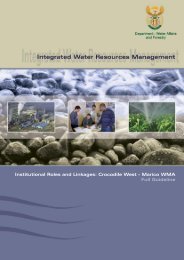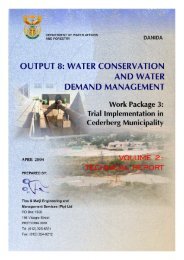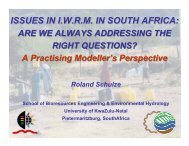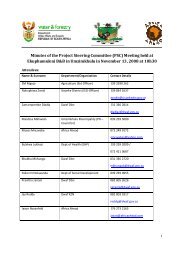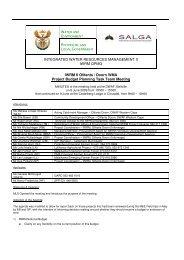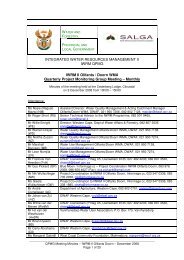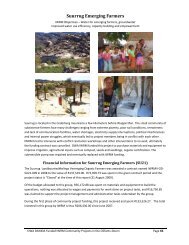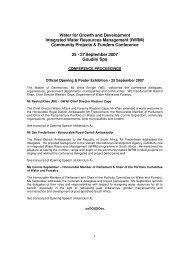You also want an ePaper? Increase the reach of your titles
YUMPU automatically turns print PDFs into web optimized ePapers that Google loves.
FLIPCHART 3: Integrated Water Resources<br />
Management (IWRM)<br />
FLIPCHART 3: Ukuphathwa Okuhlanganisiwe<br />
Kwezidingongqangi Zamanzi<br />
Message: Respect for resources and shared resourcess<br />
Umyalezo: Ukuphathwa Okuhlanganisiwe Kwezidingongqangi Zamanzi<br />
Notes to facilitator<br />
1. Ask participants if they have heard of IWRM and, if so, what they know about it. Explain that the purpose of IWRM is to teach<br />
communities about how to manage water in catchment areas sensibly. IWRM also brings communities and government<br />
together to learn about, manage, monitor and evaluate their own water resources so that there will be enough water for<br />
everyone. Show them the picture and ask them the following questions:<br />
a. How is water being managed in the picture Do you think this is a good way of managing it Give reasons for what you say.<br />
b. Do you think the community still needs rainwater tanks Why<br />
Possible answers:<br />
a. Women are queuing to get water from a tap. The water seems to be piped from storage reservoirs to standpipes with taps. One woman is<br />
rationing the water to make sure people don’t take more than they’re entitled to. The way in which water is being managed is good because<br />
the system is properly maintained and water usage is controlled.<br />
b. Even if a community has access to running water other ways of collecting water are still important. Rainwater-harvesting is a good way of<br />
conserving precious water resources.<br />
2. Tell the participants the following story, which shows how the Integrated Water Resource Management (IWRM) model can work.<br />
The women of the Nhlungwane community used to walk long distances to collect water from the uThukela river. However, a partnership between the<br />
uMzinyathi District Municipality and uThukela Water has changed their lives.<br />
How the water project works<br />
Forty taps have been installed at standpipes throughout the community, with each tap serving about five households. A diesel engine at the pump-house pumps borehole water<br />
to four storage reservoirs, from where the water flows back to the taps. There are also five handpumps in the area.<br />
The price of standpipe water is R7.00 per family per month. For this, they get 75 litres per weekday and 125 litres per weekend day. If people haven’t paid their R7.00 by the 7th<br />
of the month, they have to use a handpump. A penalty system is in place for late payments. If anyone wants more water, they must pay double. People who can’t afford to pay for<br />
water, or who need more than their daily allowance can get free water from the handpumps, but these are far from the households and sometimes run out of water.<br />
A COMMUNITY- MANAGED PROJECT<br />
The community has appointed caretakers, who manage the collection of water from the standpipes. A plumber fixes pipes and taps and services reservoirs. An operator runs the<br />
pump house and services the pump. An administrator collects the money and monitors water use. The borehole water is managed from the pumphouse. The diesel generator<br />
is serviced by the village staff.<br />
WOMEN PLAY A LEADING ROLE<br />
The chair of the project is a man, but all the caretakers of the standpipes are women, and the pump operator is also a woman. The women agree that the water project has earned<br />
them a lot of respect in the community. They have also developed new skills, like laying pipes and operating and maintaining engines.<br />
This community has really made an effort to take ownership of and manage their own water supply. They no longer have to walk long distances to fetch water and it is easier to cook,<br />
clean homes, cultivate gardens and keep livestock. Since they started getting piped water there has been no cholera in Nhlungwane.<br />
Amanothi omuntu osizayo<br />
1. Buza abantu ababambe iqhaza ukuthi bake bezwa yini nge-IWRM, uma bake bezwa, yini abayaziyo ngayo. Chaza ukuthi inhloso ye-<br />
IWRM ukufundisa imiphakathi ngokuthi amanzi aphathwa kanjani ezindaweni zokugcina amanzi emvula kahle. I-IWRM ihlanganisa<br />
imiphakathi kanye nohulumeni ndawonye bezofunda ngokuphatha, ngokuqapha kanye nokuhlela izidingongqangi zabo zamanzi ukuze<br />
kube namanzi anele awo wonke umuntu. Bakhombise isithombe bese ubabuza imibuzo elandelayo:<br />
a. Amanzi aphethwe kanjani esithombeni Ucabanga ukuthi lena indlela enhle yokuwaphatha Nikeza izizathu zalokhu okushoyo.<br />
b. Ucabanga ukuthi umphakathi usawadinga amathangi amanzi emvula Kungani<br />
Izimpendulo ezinokutholakala:<br />
a. Abesifazane bame umugqa bayokha amanzi empompini. Amanzi ngathi ahamba ngamapayipi asuka ezindaweni zokugcina amanzi aze afike<br />
kumapayipi ahlangana nompompi. Owesifazane oyedwa waba amanzi ukuqinisekisa ukuthi akekho umuntu othola ngaphezu kwalawo okufanele<br />
awathole. Indlela amanzi aphethwe ngayo yinhle ngoba uhlelo lunakekelwa kahle nokusetsenziswa kwamanzi kuyalawulwa.<br />
b. Ngisho ngabe umphakathi uyakwazi ukuthola amanzi ompompi ezinye izindlela zokuqoqa amanzi nazo zisabalulekile. Ukugcina amanzi emvula indlela<br />
enhle yokonga izidingongqangi zamanzi eziyigugu.<br />
2. Tshela abantu ababambe iqhaza indaba elandelayo, ekhombisa ukuthi isibonelo sokuPhathwa Okuhlanganisiwe Kwezidingongqangi Zamanzi<br />
(IWRM) singasebenza.<br />
Abesifazane bomphakathi waseNhlungwane babevame ukuhamba amabanga amade beyokha amanzi emfuleni uThukela. Kodwa-ke, ukubambisana phakathi<br />
kkukaMasipala Wesigodi saseMzinyathi kanye no-Thukela Water kwashintsha izimpilo zabo.<br />
ISEBENZA KANJANI IPHROJEKTHI YAMANZI<br />
Sekufakwe amapayipi amile ompompi abangamashumi amane emphakathini wonke, umpompi ngamunye usetshenziswa imizi emihlanu. Injini kadizili endlini yokumpompa impompa<br />
amanzi embotsheni ephuma amanzi phansi iwafake emapitsini okugcina amanzi amane, lapho amanzi abe esebuyela kompompi. Kunezigayo futhi ezinhlanu endaweni.<br />
Inani lentengo yepayipi lamanzi elimile ngalinye emndenini ngamunye u-R7.00 ngenyanga. Ngale mali bathola amalitha angama-75 ngosuku phakathi nesonto bese kuba amalitha<br />
angu-125 ngosuku ngempelasonto. Uma abantu bengawukhokhanga u-R7.00 wabo kuze kube umhla ka-7 wenyanga, kufanele basebenzise isigayo. Kukhona uhlelo lwenhlawulo kulabo<br />
abakhokha emva kwesikhathi. Uma kukhona umuntu ofuna amanye amanzi, kufanele akhokhe ngokuphindwe kabili. Abantu abangakwazi ukukhokhela amanzi, noma odinga amanye amanzi<br />
angaphezu kwamanzi abawanikwa zonke izinsuku, bangawathola amanzi amahhala ezigayweni, kodwa zikude nasemakhaya futhi ngezinye izikhathi ziphelelwa amanzi.<br />
IPHROJEKTHI EPHETHWE NGUMPHAKATHI<br />
Umphakathi ukhethe abantu abazonakekela, ababheka ukulandwa kwamanzi emapayipini amile. Umuntu olungisa amapayipi ulungisa amapayipi kanye nompompi bese esevisa amapitsi.<br />
Umuntu osebenzayo ubheka indlu yokumpompa bese esevisa iphampu. Umphathi uqoqa imali bese eqapha ukusetshenziswa kwamanzi. Amanzi ambiwa phansi aphathwa endlini<br />
yamaphampu. Ijenereyitha kadizili iseviswa abasebenzi basendaweni.<br />
ABESIFAZANE BABAMBE IQHAZA ELIHAMBA PHAMBILI<br />
Usihlalo wephrojekthi indoda, kodwa bonke abanakekela amapayipi amile bangabantu besifazane, kanye nomsebenzi wephampu naye ungumuntu wesifazane. Abesifazane bayavuma ukuthi<br />
iphrojekthi yamanzi isibazuzele inhlonipho enkulu emphakathini. Sebenamakhono amasha, njengokwendla amapayipi kanye nokuwasebenzisa kanye nokunakekela izinjini.<br />
Umphakathi uzamile ngempela ukuba ngabanikazi kanye nokuphatha ukunikezwa kwawo amanzi. Asisekho isidingo sokuthi bahambe amabanga amade beyokha amanzi futhi sekulula<br />
ukupheka, ukuhlanza amakhaya, ukulima izingadi kanye nokugcina imffuyo. Selokhu nje kwaqala amanzi aphuma emapayipini ayisekho ikholera eNhlungwane.<br />
3. Now ask participants the following questions:<br />
a. How are the community members involved in managing the water<br />
b. In what way is the community being uplifted<br />
c. What are the water needs in your community<br />
d. Can you manage the water resources within your own community, as the women of Nhlungwane do What help would you need<br />
e. In the story the uMzinyathi District Municipality is the Water Services Authority (WSA) and uThukela Water Partnership the<br />
Water Services Provider (WSP). Who is your WSA and, where appropriate, your WSP<br />
f. The women of Nhlungwane made the project work for themselves. There are further possibilities of improved services through<br />
working together with their WSA and WSP. How can you make these contacts in your own community to manage your water<br />
resources in the most sustainable way<br />
Possible answers<br />
a. Community members meet and discuss water issues, and appoint skilled people to oversee the taps and maintain the water system.<br />
b. People don’t have to fetch water from the river anymore so they have more time for activities that have economic benefits like growing food or working. Easy<br />
access to clean, safe water means they are healthier. People have also learned new skills in order to manage their own water supply. Children won’t miss<br />
school due to illness so education levels should improve. The fact that the water project is mainly run by women increases their status in the community.<br />
3. Manje buza abantu ababambe iqhaza imibuzo elandelayo:<br />
a. Amalungu omphakathi abandakanyeka kanjani ekuphathweni kwamanzi<br />
b. Umphakathi ukhushulwa ngayiphi indlela<br />
c. Ziyini izidingo zama nzi emphakathini wakini<br />
d. Ungakwazi ukuphatha izidingongqangi zamanzi emphakathini wangakini uqobo, njengoba kwenza abesifazane baseNhlungwane<br />
Ungadinga lusizo luni<br />
e. Endabeni, Umzinyathi District Municipality Uyiziphathimandla Zezinsizakalo Zamanzi (Water Services Authority (WSA)) bese kuthi<br />
u-Thukela Water Partnership ube Umnikezeli Wezinsizakalo Zamanzi (Water Services Provider (WSP)). Ubani ongu-WSA wenu futhi<br />
lapho kufanele khona, ubani i-WSP yenu<br />
f. Abantu besifazane baseNhlungwane benza ukuthi iphrojekthi isebenze ngokwabo. Kungenzeka futhi ukuthi kube nezinsizakalo<br />
ezenziwe ngcono ngokusebenzisana nama-WSA kanye nama-WSP abo. Ungathintana kanjani nabanye abantu emphakathini wakho<br />
ukuze iphathe izidingongqangi zamanzi ngendlela eqhubekayo<br />
Izimpendulo ezinokutholakala:<br />
a. Amalungu omphakathi ayahlangana bese exoxa ngezindaba zamanzi, futhi uqashe abantu abanamakhono ukuthi babheke ompompi futhi banakekele<br />
uhlelo lwamanzi.<br />
b. Asisekho isidingo sokuthi abantu balande amanzi emfuleni ukuze babe nesikhathi esiningi sokwenza imisebenzi enezinzuzo zezomnotho njengokulima<br />
ukudla noma ukusebenza. Ukuthola kalula amanzi ahlanzekile, aphephile kusho ukuthi anempilo. Abantu sebefunde namakhono amasha ukuze<br />
baziphathele ukunikezelwa kwamanzi abo. Izingane angeke ziphuthe esikoleni ngenxa yokugula, ngakho-ke amazinga emfundo kufanele abe ngcono.<br />
Ukuthi nje iphrojekthi yamanzi iphethwe ngabantu besifazane kukhuphula indawo yabo emphakathini.<br />
Definition box<br />
catchment area: the area from which a river or dam is fed<br />
© MiET Africa and Africa!Ignite 2007<br />
Ibhokisi lezincazelo<br />
Indawo yomlomo womfula: indawo umfula noma idamu elingenisa kuyo<br />
<strong>Flipchart</strong> 3



